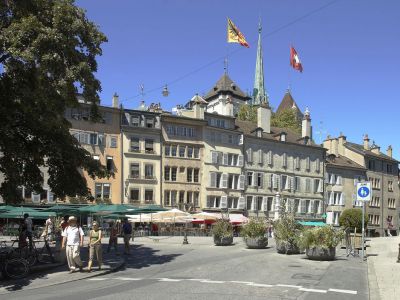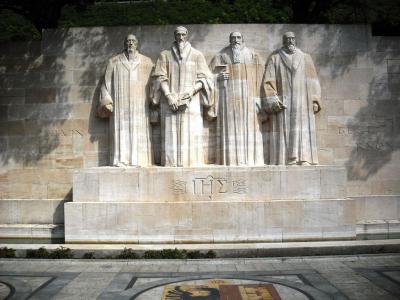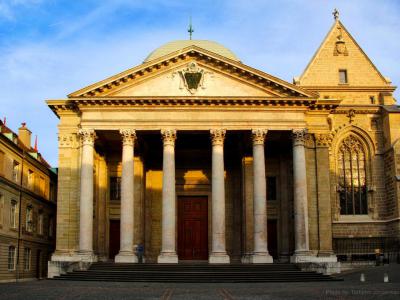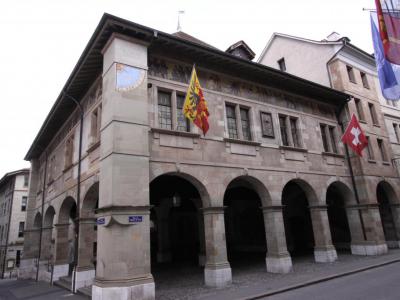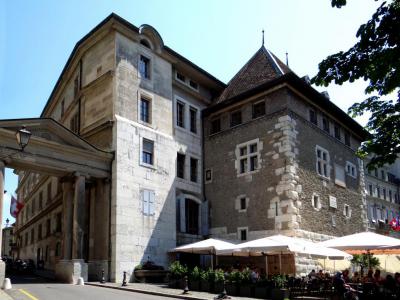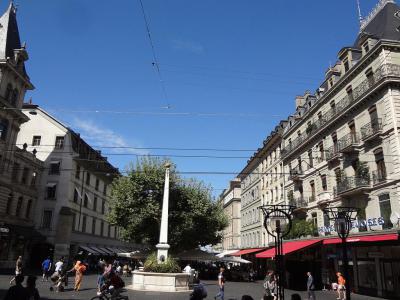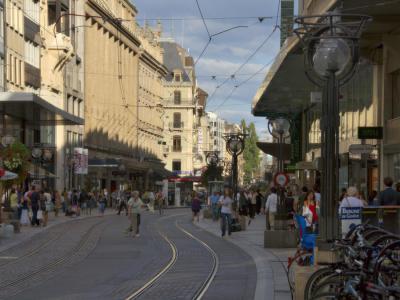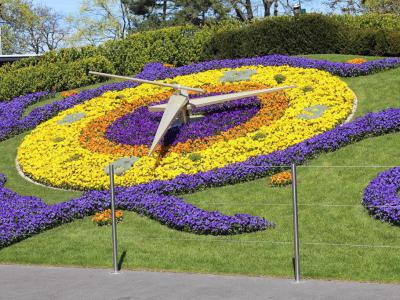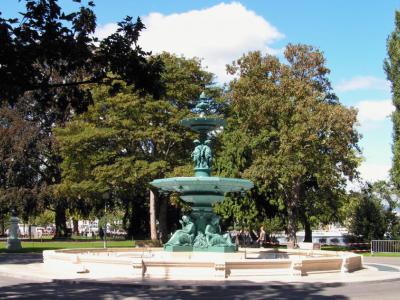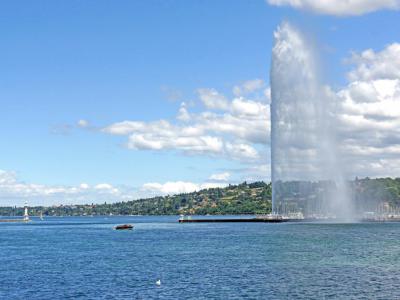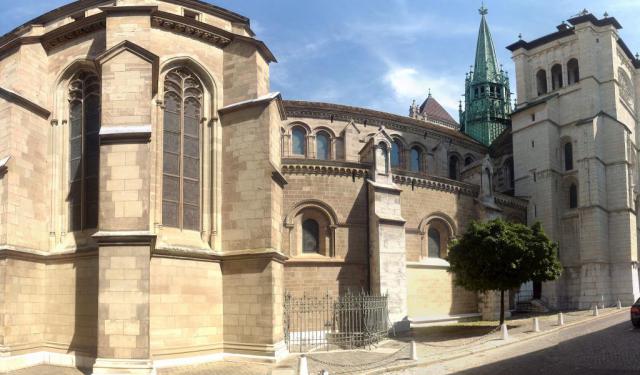Geneva Introduction Walking Tour (Self Guided), Geneva
The city of Geneva enjoys picturesque location at the southern tip of the expansive Lac Léman (aka Lake Geneva), surrounded by the Alps and Jura mountains, including the dramatic Mont Blanc peak.
The city was mentioned for the first time in Latin texts, by Caesar, with the spelling Genava, derived probably from the Celtic genawa- or genu- ("bend, knee"), in the sense of a bending river or estuary. It was an Allobrogian border town, fortified against the Helvetii tribe, when the Romans took it in 121 BC. The town became Christian under the Late Roman Empire, and acquired its first bishop in the 5th century, having been connected to the Bishopric of Vienne in the 4th.
After 1400 medieval county of Geneva became the Genevois province of Savoy (albeit not extending to the city proper, until the reformation of the seat of the Bishop of Geneva). In the Middle Ages, Geneva was ruled by a count under the Holy Roman Empire until the late 14th century, when it was granted a charter giving it a high degree of self-governance. In the first half of the 16th century, the Protestant Reformation reached the city, causing religious strife, during which Savoy rule was thrown off and Geneva allied itself with the Swiss Confederacy.
In 1541, with Protestantism on the rise, John Calvin, the Protestant Reformer and proponent of Calvinism, became the spiritual leader of the city and established the Republic of Geneva. By the 18th century, Geneva had come under the influence of Catholic France, which cultivated the city as its own. At the end of the Napoleonic Wars, on 1 June 1814, Geneva was admitted to the Swiss Confederation. The French influence, however, is still widespread here, from the language to gastronomy and more.
Geneva flourished in the 19th and 20th centuries, becoming the seat of many international organizations, such as the Headquarters of Europe’s United Nations and the Red Cross, and a global hub for diplomacy and banking.
Today mostly known as the city of watches and jewelry making, Geneva boasts of number of notable landmarks, such as the famous Jet D’eau, the Flower Clock, to mention but a few. To acquaint yourself with these and other attractions of Geneva, take this self-guided tour.
The city was mentioned for the first time in Latin texts, by Caesar, with the spelling Genava, derived probably from the Celtic genawa- or genu- ("bend, knee"), in the sense of a bending river or estuary. It was an Allobrogian border town, fortified against the Helvetii tribe, when the Romans took it in 121 BC. The town became Christian under the Late Roman Empire, and acquired its first bishop in the 5th century, having been connected to the Bishopric of Vienne in the 4th.
After 1400 medieval county of Geneva became the Genevois province of Savoy (albeit not extending to the city proper, until the reformation of the seat of the Bishop of Geneva). In the Middle Ages, Geneva was ruled by a count under the Holy Roman Empire until the late 14th century, when it was granted a charter giving it a high degree of self-governance. In the first half of the 16th century, the Protestant Reformation reached the city, causing religious strife, during which Savoy rule was thrown off and Geneva allied itself with the Swiss Confederacy.
In 1541, with Protestantism on the rise, John Calvin, the Protestant Reformer and proponent of Calvinism, became the spiritual leader of the city and established the Republic of Geneva. By the 18th century, Geneva had come under the influence of Catholic France, which cultivated the city as its own. At the end of the Napoleonic Wars, on 1 June 1814, Geneva was admitted to the Swiss Confederation. The French influence, however, is still widespread here, from the language to gastronomy and more.
Geneva flourished in the 19th and 20th centuries, becoming the seat of many international organizations, such as the Headquarters of Europe’s United Nations and the Red Cross, and a global hub for diplomacy and banking.
Today mostly known as the city of watches and jewelry making, Geneva boasts of number of notable landmarks, such as the famous Jet D’eau, the Flower Clock, to mention but a few. To acquaint yourself with these and other attractions of Geneva, take this self-guided tour.
How it works: Download the app "GPSmyCity: Walks in 1K+ Cities" from Apple App Store or Google Play Store to your mobile phone or tablet. The app turns your mobile device into a personal tour guide and its built-in GPS navigation functions guide you from one tour stop to next. The app works offline, so no data plan is needed when traveling abroad.
Geneva Introduction Walking Tour Map
Guide Name: Geneva Introduction Walking Tour
Guide Location: Switzerland » Geneva (See other walking tours in Geneva)
Guide Type: Self-guided Walking Tour (Sightseeing)
# of Attractions: 10
Tour Duration: 2 Hour(s)
Travel Distance: 2.6 Km or 1.6 Miles
Author: john
Sight(s) Featured in This Guide:
Guide Location: Switzerland » Geneva (See other walking tours in Geneva)
Guide Type: Self-guided Walking Tour (Sightseeing)
# of Attractions: 10
Tour Duration: 2 Hour(s)
Travel Distance: 2.6 Km or 1.6 Miles
Author: john
Sight(s) Featured in This Guide:
- Place du Bourg-de-Four (Bourg-de-Four Square)
- Mur des Réformateurs (Reformation Wall)
- Cathédrale de St. Pierre (Saint Peter Cathedral)
- Old Arsenal (Ancien Arsenal)
- Hôtel de Ville (Geneva Town Hall)
- Place du Molard (Molard Square and Tower)
- Rue du Rhône (Rhone Street)
- Horloge Fleurie (Flower Clock)
- Jardin Anglais (English Garden)
- Jet d'Eau (Water-Jet)
1) Place du Bourg-de-Four (Bourg-de-Four Square) (must see)
"Place du Bourg-de-Four" is the French translation for the Latin term "Forum of the Burgundians." The reference is also to the Castle of Gomdebaud, king of the Burgundians, who died in 516. From its beginnings, the square has been a venue for markets and fairs. Today it is also a tourist magnet.
Unlike most city squares having a large open space, the Bourg-du-Four is shaped more like an hour-glass. The north side, dominated by the Palace of Justice, ultimately divides into Fountain Street (Rue de la Fontaine) and Verdaine Street (Rue Verdaine). Between these two is the Lutheran Church.
The south side looks more like a city square. The fountain and surrounding buildings form a harmonious grouping, bordering a small, tree-lined promenade and a minute square ("placette") at the start of the Town Hall Street (Rue de l'Hotel-de-Ville).
From the marble fountain, looking east, one can see the Palace of Justice (Palais de Justice). Facing the police station is Saint Peter's Cathedral, the largest church in Geneva. Around the square are gelaterias, cafes, book shops, galleries, bars and bistros. Once a cattle market, the square now offers high-end shopping.
Another point of interest is the Passage des Degres-de-Poules ("Chicken Coop Walkway"), a narrow passage on the north side. It is a staircase of 67 steps leading up to Saint Peter's Cathedral. It is a bit wider than two chickens walking abreast.
Unlike most city squares having a large open space, the Bourg-du-Four is shaped more like an hour-glass. The north side, dominated by the Palace of Justice, ultimately divides into Fountain Street (Rue de la Fontaine) and Verdaine Street (Rue Verdaine). Between these two is the Lutheran Church.
The south side looks more like a city square. The fountain and surrounding buildings form a harmonious grouping, bordering a small, tree-lined promenade and a minute square ("placette") at the start of the Town Hall Street (Rue de l'Hotel-de-Ville).
From the marble fountain, looking east, one can see the Palace of Justice (Palais de Justice). Facing the police station is Saint Peter's Cathedral, the largest church in Geneva. Around the square are gelaterias, cafes, book shops, galleries, bars and bistros. Once a cattle market, the square now offers high-end shopping.
Another point of interest is the Passage des Degres-de-Poules ("Chicken Coop Walkway"), a narrow passage on the north side. It is a staircase of 67 steps leading up to Saint Peter's Cathedral. It is a bit wider than two chickens walking abreast.
2) Mur des Réformateurs (Reformation Wall) (must see)
Inaugurated in 1909, the Reformation Wall celebrates persons and events of the Protestant Reformation using bas-reliefs. On the grounds of the University of Geneva, the Reformation Wall marks the 400th anniversary of French reformer John Calvin's birth and the 350th anniversary of Calvin's founding of the University.
The wall is built into the Old City walls, emphasizing the role the city and its fortifications played in the drama of the Reformation. The monument was the result of a worldwide competition. Seventy-one designs were submitted. Four Swiss architects were picked: Charles Dubois, Alphonse Laverrier, Eugene Monod, and Jean Taillens.
Due to the close connections to Protestantism, the individuals most prominently depicted on the Wall were Calvinists; however, key figures in other theologies are also included. The sculptures were created by French artists Paul Landowski and Henri Bouchard. At the center of the monument stand four statues, each over 16 feet tall, representing the prominent figures of Calvinism: William Farel, John Calvin, Theodore Beza, and Kohn Knox. They wear scholastic robes and carry small bibles.
On the left of the group are three 10-foot figures of Fredrick Willam of Brandenburg, Willam the Silent, and Gaspard de Coligny. On the right are the figures of Roger Williams, Oliver Cromwell, and Stephen Bocskai. A motto declares in Latin: "After darkness, light."
The wall is built into the Old City walls, emphasizing the role the city and its fortifications played in the drama of the Reformation. The monument was the result of a worldwide competition. Seventy-one designs were submitted. Four Swiss architects were picked: Charles Dubois, Alphonse Laverrier, Eugene Monod, and Jean Taillens.
Due to the close connections to Protestantism, the individuals most prominently depicted on the Wall were Calvinists; however, key figures in other theologies are also included. The sculptures were created by French artists Paul Landowski and Henri Bouchard. At the center of the monument stand four statues, each over 16 feet tall, representing the prominent figures of Calvinism: William Farel, John Calvin, Theodore Beza, and Kohn Knox. They wear scholastic robes and carry small bibles.
On the left of the group are three 10-foot figures of Fredrick Willam of Brandenburg, Willam the Silent, and Gaspard de Coligny. On the right are the figures of Roger Williams, Oliver Cromwell, and Stephen Bocskai. A motto declares in Latin: "After darkness, light."
3) Cathédrale de St. Pierre (Saint Peter Cathedral) (must see)
The locale of the Cathedral of Saint Peter in Geneva has been the site of a cathedral and the seat of a bishop since the 4th century. The present cathedral was the work of the Prince-Bishop of the diocese, Arducius de Faucigny, in 1160. It was begun in the Gothic style, and there have been some changes since then.
The Cathedral of Saint Peter combines styles with a Neo-Classical Roman temple portico adjoined to a high-steepled Gothic edifice with a tall mullioned window. In 1535 French theologian John Calvin and the Reformation arrived in Geneva. Calvin adopted the cathedral as his home church, ushering in an age of architectural iconoclasm.
The cathedral was mostly stripped. The altars, all of the statues, and most paintings were destroyed or removed. The pulpit and some paintings were spared. The interior is spacious and plain, illuminated by hanging chandeliers. There are rows of benches and a few chapels. The aisles hold tombstones of 15th and 16th-century church dignitaries.
At the highest point of the Old Town, there is a stunning panorama for visitors hardy enough to brave the 157 steps of the north tower. The cathedral is often a venue for concerts. There is an archeological site in the crypt with artifacts of a 4th-century basilica. The 14th-century Chapel of the Maccabees should not be missed.
An enormous pipe organ is situated above the main entrance. It has the appearance of a red and gold crown. Loudspeakers are installed to magnify the already sonorous sound. If that is not enough, another, smaller organ is in the front on the left side. John Calvin's triangular stool is still next to the pulpit.
On the north side of the cathedral is the International Museum of the Reformation. The museum is open from Tuesday to Sunday from 10 am to 5 pm. A five-minute walk away is the Museum of Art and History. It has historical artifacts from the cathedral and the Saint Peter altarpiece painted by German artist Konrad Witz.
The Tower clock strikes every hour, followed by a tune on the glockenspiel, sometimes it's the Swiss National Anthem.
The Cathedral of Saint Peter combines styles with a Neo-Classical Roman temple portico adjoined to a high-steepled Gothic edifice with a tall mullioned window. In 1535 French theologian John Calvin and the Reformation arrived in Geneva. Calvin adopted the cathedral as his home church, ushering in an age of architectural iconoclasm.
The cathedral was mostly stripped. The altars, all of the statues, and most paintings were destroyed or removed. The pulpit and some paintings were spared. The interior is spacious and plain, illuminated by hanging chandeliers. There are rows of benches and a few chapels. The aisles hold tombstones of 15th and 16th-century church dignitaries.
At the highest point of the Old Town, there is a stunning panorama for visitors hardy enough to brave the 157 steps of the north tower. The cathedral is often a venue for concerts. There is an archeological site in the crypt with artifacts of a 4th-century basilica. The 14th-century Chapel of the Maccabees should not be missed.
An enormous pipe organ is situated above the main entrance. It has the appearance of a red and gold crown. Loudspeakers are installed to magnify the already sonorous sound. If that is not enough, another, smaller organ is in the front on the left side. John Calvin's triangular stool is still next to the pulpit.
On the north side of the cathedral is the International Museum of the Reformation. The museum is open from Tuesday to Sunday from 10 am to 5 pm. A five-minute walk away is the Museum of Art and History. It has historical artifacts from the cathedral and the Saint Peter altarpiece painted by German artist Konrad Witz.
The Tower clock strikes every hour, followed by a tune on the glockenspiel, sometimes it's the Swiss National Anthem.
4) Old Arsenal (Ancien Arsenal)
The Old Arsenal (French: Ancien Arsenal) is a former militarily installation in the heart of Geneva's Old Town, located just a stone's throw from the Town Hall. Back in the day, it was used for storing arms and gun powder, but today serves a more peaceful function, housing the State Archives.
The building’s architecture, resembling a fortified mansion with five cannons set to defend the city against the attackers, recalls Geneva's distant warlike past. Under the Romans, this site was an open-air market, and was covered only in the early 15th century. In 1588, arcades were added, upon which a granary was built that was eventually transformed into a military depot, between 1720 and 1877.
Presently, underneath these arcades is a compact artillery museum with a collection of five period cannons, similar to those used to defend ramparts of the city, plus three colorful, battle-themed mosaics depicting key periods in the local history, namely: the arrival of Julius Caesar in 58 BC; the Fairs of the Middle Ages; and the reception of Huguenot refugees after the Revocation of the Edict of Nantes.
Also, each year on December 11 or the closest weekend, visitors to the Old Arsenal can treat themselves to some vegetable soup served here in commemorative bowls during the historic Escalade festival, celebrating the ill-fated attempt to conquer the Protestant city of Geneva by the Catholic Duchy of Savoy in 1602-1603.
The building’s architecture, resembling a fortified mansion with five cannons set to defend the city against the attackers, recalls Geneva's distant warlike past. Under the Romans, this site was an open-air market, and was covered only in the early 15th century. In 1588, arcades were added, upon which a granary was built that was eventually transformed into a military depot, between 1720 and 1877.
Presently, underneath these arcades is a compact artillery museum with a collection of five period cannons, similar to those used to defend ramparts of the city, plus three colorful, battle-themed mosaics depicting key periods in the local history, namely: the arrival of Julius Caesar in 58 BC; the Fairs of the Middle Ages; and the reception of Huguenot refugees after the Revocation of the Edict of Nantes.
Also, each year on December 11 or the closest weekend, visitors to the Old Arsenal can treat themselves to some vegetable soup served here in commemorative bowls during the historic Escalade festival, celebrating the ill-fated attempt to conquer the Protestant city of Geneva by the Catholic Duchy of Savoy in 1602-1603.
5) Hôtel de Ville (Geneva Town Hall)
For over 500 years, Geneva’s Town Hall has been at the heart of local and even international political life. As the seat of the government of the Canton and the Republic of Geneva, this place has witnessed a number of events of great historic importance.
In 1864, the building’s Alabama Room saw the signing of the very first Geneva Convention, the founding act of the International Red Cross. Also, in 1872 it was here that the international arbitration court ended a long-standing conflict between the United States of America and Great Britain.
The 16th century building boasts three stories of neoclassical design, with a large courtyard and a huge paved ramp. The ramp is a unique cobbled spiral staircase built between 1555 and 1578 enclosed within a square tower, allowing direct access to the upper floors on horseback. Today, visitors can walk up in their forefathers' “hoof-steps” only on foot!
In 1864, the building’s Alabama Room saw the signing of the very first Geneva Convention, the founding act of the International Red Cross. Also, in 1872 it was here that the international arbitration court ended a long-standing conflict between the United States of America and Great Britain.
The 16th century building boasts three stories of neoclassical design, with a large courtyard and a huge paved ramp. The ramp is a unique cobbled spiral staircase built between 1555 and 1578 enclosed within a square tower, allowing direct access to the upper floors on horseback. Today, visitors can walk up in their forefathers' “hoof-steps” only on foot!
6) Place du Molard (Molard Square and Tower)
Once described as Geneva's “economic lung, urban matrix, and political arena”, Molard Square is one of the city's oldest commercial areas since the 16th century. The first mention of it as a port dates back to 1271. The word "molard" is the Latin for levee of earth and probably refers to a riprap, a dyke, that used to protect the port. In 1309, the first hard hall was built in the area, making it a commercial and customs port.
In the 16th century, the area around Molard became an economic center of the city fitted with warehouses, customs and foreign exchange offices, hotels, numerous craft shops, public writers and notary benches, printers, etc. Eventually, there appeared a fish and poultry market with new halls established in 1690.
At the center of the square is the Molard Tower (aka Clock Tower) which is a remnant of the defensive wall that used to protect the port of Molard in the Middle Ages. In 1906 it was adorned with a painted frieze taken from the demolished house of Rolle. The frieze features the coats of arms of the key actors in the Reformation history and a sculpture, called “Geneva city of Refuge”. Some find the male character depicted on the sculpture to bear a striking resemblance to Vladimir Lenin, although there is no proof that the author used Lenin as a model.
In addition to that, the square hosts a myriad of small boutiques and big brand stores, plus a number of excellent souvenir shops. Twice a week, Molard Square transforms into an open-air flea market organized by local authorities.
In the 16th century, the area around Molard became an economic center of the city fitted with warehouses, customs and foreign exchange offices, hotels, numerous craft shops, public writers and notary benches, printers, etc. Eventually, there appeared a fish and poultry market with new halls established in 1690.
At the center of the square is the Molard Tower (aka Clock Tower) which is a remnant of the defensive wall that used to protect the port of Molard in the Middle Ages. In 1906 it was adorned with a painted frieze taken from the demolished house of Rolle. The frieze features the coats of arms of the key actors in the Reformation history and a sculpture, called “Geneva city of Refuge”. Some find the male character depicted on the sculpture to bear a striking resemblance to Vladimir Lenin, although there is no proof that the author used Lenin as a model.
In addition to that, the square hosts a myriad of small boutiques and big brand stores, plus a number of excellent souvenir shops. Twice a week, Molard Square transforms into an open-air flea market organized by local authorities.
7) Rue du Rhône (Rhone Street)
Rhone Street is one of the best-known shopping lanes in downtown Geneva. However up until the 15th century the area where Rhone Street is today was still the shore of Lake Geneva. Historically, this street was a gathering spot for horse-dealers and a place for fodder warehouses. It gradually took its current form in the 18th century, and was extended further east from the riverside in the middle of the 19th century.
Today, Rhone Street is a shopper's paradise. If you're a shopaholic, your eyes will sparkle in this bevy of temptations, featuring practically all the known luxury brands, vying with one another in elegance and style. Shopping addicts will find all their dreams come true at Rhone Street, as the local retailers are committed to fulfilling all your longings for luxury, be it watches, fashion or jewelry, handmade chocolate or whatever else you may discover (or rediscover) in what has given Geneva its reputation. Nowhere else will you find such a dense concentration of prestige!
You'll need at least half a day to resist this! And if you're craving for a break while shopping, come and admire the Malbuisson Clock, its chime and mechanical procession, which scrolls by every hour.
Albeit ultimately posh, this shopping street does have some sales taking place here also. So, if lucky, you can grab a bargain in one or more of the local stores.
Today, Rhone Street is a shopper's paradise. If you're a shopaholic, your eyes will sparkle in this bevy of temptations, featuring practically all the known luxury brands, vying with one another in elegance and style. Shopping addicts will find all their dreams come true at Rhone Street, as the local retailers are committed to fulfilling all your longings for luxury, be it watches, fashion or jewelry, handmade chocolate or whatever else you may discover (or rediscover) in what has given Geneva its reputation. Nowhere else will you find such a dense concentration of prestige!
You'll need at least half a day to resist this! And if you're craving for a break while shopping, come and admire the Malbuisson Clock, its chime and mechanical procession, which scrolls by every hour.
Albeit ultimately posh, this shopping street does have some sales taking place here also. So, if lucky, you can grab a bargain in one or more of the local stores.
8) Horloge Fleurie (Flower Clock) (must see)
Geneva is renowned worldwide for its rich watchmaking heritage, often referred to as the epicenter of high-end timepieces. In 1955, as a tribute to this time-honored tradition and a dedication to nature, the Flower Clock was introduced on the western side of the English Garden in Geneva.
This remarkable clock boasts a diameter of 5 meters (approximately 16 feet) and features a second hand measuring 2.5 meters (around 8.2 feet) in length. Crafting the clock face required the use of approximately 6,500 flowering plants and shrubs. For several decades, Geneva's Flower Clock held the distinction of being the world's largest outdoor clock composed of flowers. However, in 2005, it ceded this title to a 15-meter (approximately 49-foot) counterpart in Tehran, Iran.
What's truly remarkable about this Swiss masterpiece is that it has faithfully operated for over half a century without ever experiencing a moment of downtime. Even more fascinating is the fact that it undergoes a perpetual transformation, as it is constructed using various types of flowers that bloom at different times throughout the year. With each passing season, the plants are changed, ushering in a fresh palette of colors and making the Flower Clock a truly distinctive sight. It's worth noting that the entire mosaic is created and maintained in an environmentally friendly manner, without the use of harmful chemicals.
This remarkable clock boasts a diameter of 5 meters (approximately 16 feet) and features a second hand measuring 2.5 meters (around 8.2 feet) in length. Crafting the clock face required the use of approximately 6,500 flowering plants and shrubs. For several decades, Geneva's Flower Clock held the distinction of being the world's largest outdoor clock composed of flowers. However, in 2005, it ceded this title to a 15-meter (approximately 49-foot) counterpart in Tehran, Iran.
What's truly remarkable about this Swiss masterpiece is that it has faithfully operated for over half a century without ever experiencing a moment of downtime. Even more fascinating is the fact that it undergoes a perpetual transformation, as it is constructed using various types of flowers that bloom at different times throughout the year. With each passing season, the plants are changed, ushering in a fresh palette of colors and making the Flower Clock a truly distinctive sight. It's worth noting that the entire mosaic is created and maintained in an environmentally friendly manner, without the use of harmful chemicals.
9) Jardin Anglais (English Garden)
Covering an area of 25,430 square meters, Geneva's English Garden is a large and lush urban park. Established in 1855, it features a design inspired by classic English landscape gardens. The park's shape was significantly altered to a trapezoidal form in 1863 due to the construction of the nearby Mont Blanc bridge.
The English Garden is not only a popular spot for visitors but also houses several significant landmarks. These include the National Monument, the renowned Flower Clock, the Four Seasons Fountain crafted in bronze, various pavilions, and a café named "The Gossips," which is a perfect spot for a casual hangout.
Among the park's attractions is the Geneve Boat, known for a tragic event in 1898 when Austrian Empress Sissi, fatally wounded by an Italian anarchist, sought to apprehend her attacker on this boat but succumbed to her injuries. Today, the boat operates as a charitable organization, providing counseling and free meals to those in need and also serving meals to tourists.
The park also honors Swiss artists through three busts, commemorating painters Alexandre Calame, François Diday, and sculptor Auguste Rodo de Niederhausen. Every year, from mid-July to mid-August, the English Garden is one of the venues for the Geneva Festival.
Remarkably, the park contains several ancient trees, including a ginkgo planted in 1863 and a purple beech from 1895, planted during the National Exhibition. Other notable trees are a giant cedar, a grand sequoia, a magnolia with large flowers, horse chestnuts, a tulip tree, and more. The park's greenery is maintained using eco-friendly practices, avoiding chemical treatments.
The English Garden is not only a popular spot for visitors but also houses several significant landmarks. These include the National Monument, the renowned Flower Clock, the Four Seasons Fountain crafted in bronze, various pavilions, and a café named "The Gossips," which is a perfect spot for a casual hangout.
Among the park's attractions is the Geneve Boat, known for a tragic event in 1898 when Austrian Empress Sissi, fatally wounded by an Italian anarchist, sought to apprehend her attacker on this boat but succumbed to her injuries. Today, the boat operates as a charitable organization, providing counseling and free meals to those in need and also serving meals to tourists.
The park also honors Swiss artists through three busts, commemorating painters Alexandre Calame, François Diday, and sculptor Auguste Rodo de Niederhausen. Every year, from mid-July to mid-August, the English Garden is one of the venues for the Geneva Festival.
Remarkably, the park contains several ancient trees, including a ginkgo planted in 1863 and a purple beech from 1895, planted during the National Exhibition. Other notable trees are a giant cedar, a grand sequoia, a magnolia with large flowers, horse chestnuts, a tulip tree, and more. The park's greenery is maintained using eco-friendly practices, avoiding chemical treatments.
10) Jet d'Eau (Water-Jet) (must see)
The Water-Jet (Jet d'Eau) is a prominent fountain located in Geneva and stands as one of the city's key attractions. Originally established in 1886, its primary function was to act as a safety release for a hydraulic power network. Positioned initially at a different site, the fountain was later moved in 1891 to its current location as a part of the celebration for the Federal Gymnastics Festival and the Swiss Confederation's 600th anniversary. The current version of the Water-Jet was installed in 1951, housed in a partly submerged pumping station.
Today, it's recognized as one of the world's tallest fountains and is a distinct feature of the Geneva skyline, even visible from up to 10 kilometers (about 33,000 feet) in the air. The fountain propels 500 liters (132 gallons) of water per second to a height of 140 meters (459 feet) at a speed of 200 kilometers per hour (124 miles per hour). At any moment, approximately 7,000 liters (1,849 gallons) of water are in the air.
Visitors can access the fountain via a stone pier on the lake's left bank. However, they should be wary of sudden wind shifts that can lead to an unexpected soaking.
Since 2003, the Water-Jet has been operational during daylight hours throughout the year, weather permitting, and also functions in the evenings from spring to autumn, enhanced by 21 lights.
Today, it's recognized as one of the world's tallest fountains and is a distinct feature of the Geneva skyline, even visible from up to 10 kilometers (about 33,000 feet) in the air. The fountain propels 500 liters (132 gallons) of water per second to a height of 140 meters (459 feet) at a speed of 200 kilometers per hour (124 miles per hour). At any moment, approximately 7,000 liters (1,849 gallons) of water are in the air.
Visitors can access the fountain via a stone pier on the lake's left bank. However, they should be wary of sudden wind shifts that can lead to an unexpected soaking.
Since 2003, the Water-Jet has been operational during daylight hours throughout the year, weather permitting, and also functions in the evenings from spring to autumn, enhanced by 21 lights.
Walking Tours in Geneva, Switzerland
Create Your Own Walk in Geneva
Creating your own self-guided walk in Geneva is easy and fun. Choose the city attractions that you want to see and a walk route map will be created just for you. You can even set your hotel as the start point of the walk.
Historical Churches
As the cradle of the Reformist movement in Europe led by theologian Jean Calvin, the city of Geneva has no shortage of religious sites representing a great deal of historical and cultural value. A dedicated Christian, a keen churchgoer, or simply one who is interested in objects of spirituality will find here quite a few temples worthy of attention.
Whether you're drawn to the austere... view more
Tour Duration: 1 Hour(s)
Travel Distance: 2.2 Km or 1.4 Miles
Whether you're drawn to the austere... view more
Tour Duration: 1 Hour(s)
Travel Distance: 2.2 Km or 1.4 Miles
Architectural Jewels
Geneva, a city renowned for its diplomatic prowess and picturesque landscapes, boasts an array of architectural jewels. The remarkable medieval and more contemporary structures such as Geneva Town Hall (Hôtel de Ville), Saint Peter Cathedral (Cathedrale de Saint-Pierre), and Schtroumph Buildings, showing a mix of French and German influences, have captivated both locals and tourists for decades.
... view more
Tour Duration: 2 Hour(s)
Travel Distance: 2.6 Km or 1.6 Miles
... view more
Tour Duration: 2 Hour(s)
Travel Distance: 2.6 Km or 1.6 Miles
Chocolate Tour
Chocolate started to gain popularity in Switzerland in the early 16th century and has since evolved to become a highly appreciated Swiss commodity throughout the world. Almost every city or town in the country has at least one chocolate shop, and Geneva is by far no exception.
The local chocolate scene is a true delight for any cocoa enthusiast. Here, you'll find a handful of iconic... view more
Tour Duration: 1 Hour(s)
Travel Distance: 1.5 Km or 0.9 Miles
The local chocolate scene is a true delight for any cocoa enthusiast. Here, you'll find a handful of iconic... view more
Tour Duration: 1 Hour(s)
Travel Distance: 1.5 Km or 0.9 Miles
Best Swiss Watch Shops Tour
When it comes to quality and precision, Swiss-made watches are known to be the best. Some of the world-renowned watch brands have been designed and masterminded in Geneva. The city's watch industry dates back to the 16th century, and since then has constantly developed to produce the most desired timepieces.
Geneva hosts a cluster of specialized shops that cater to the refined tastes of... view more
Tour Duration: 1 Hour(s)
Travel Distance: 1.2 Km or 0.7 Miles
Geneva hosts a cluster of specialized shops that cater to the refined tastes of... view more
Tour Duration: 1 Hour(s)
Travel Distance: 1.2 Km or 0.7 Miles
The Most Popular Cities
/ view all



